Deciding between a front-load washer and a top-load washer can be tough.
It gets even more confusing when you consider all the laundry options available today.
You’ve got the popular hybrid top-load washers, the newer combo washer-dryer units, and ventless washer-dryer towers with heat pump technology.
In this article, you’ll learn the pros and cons of each type, including one style of washer you should never buy.
You’ll also see the reliability of all types based on over 37,000 service calls logged by our service team just last year.
Stick around until the end, and I’ll share a simple hack to detect water leaks in your newly installed washing machine or any other appliance.
It’ll cost you less than a dollar, and this trick received rave reviews on our video.
But first, a bit of personal perspective.
[inlineCTA]
My Personal Experience with Front & Top Load Washers
The first appliance I ever sold was a Maytag top-load washer, 42 years ago.
Over the past 20 years, I’ve used front-load washers from Miele, Electrolux, and Maytag.
For a bit of culture shock, I moved into an apartment with a traditional Kenmore top-load washer. It’s been quite an adjustment.
Last year, after using front-load washers for two decades, I found myself back with a top-load washer.
The advantage? You don’t have to wipe down the gasket or leave the door open like you do with a front-load washer to prevent mold.
I also don’t have to bend down to fill or remove clothes, which is a nice change from my front-load experience.
However, there are trade-offs. You’ll use a lot more water and detergent with a top-load washer.
Capacity is another issue, especially when it comes to washing comforters.
The usable capacity of any top-load washer is less because of the agitator, which is particularly noticeable with blankets and comforters.
You can stuff them in, but you’ll need at least two cycles to dry them.
The agitator in a top-load washer also creates more lint. And since the washer spins much slower than the front-loaders, the dryer has to work harder to get the clothes fully dry.
Throughout this article, I’ll give you a balanced perspective on the pros and cons.
Let’s start by breaking down the first two myths and look at the reliability differences between front and top-load washers in 2024.
Front Load vs. Top Load Washers: Which Is Better?
Front Load vs. Top Load Washers: Reliability
Below are our most recent reliability stats for front-load and top-load washers.
We calculate washer reliability by dividing the number of products we serviced by the number of products we sold.
Front Load Washer Reliability
The following service rates are based on a minimum of 100 products sold and a total sample of over 2,000 products within 12 months
| Service Rates | |
| Whirlpool | 4.1% |
| LG | 4.9% |
| GE | 7.4% |
| Grand Total | 5.6% |
The most reliable front-load washers are determined by a minimum of 300 units sold per brand, with a total sample of over 3,000 from December 2022 to December 2023.
The average repair rate for front-load washers is 5.6%, or about 4% better than appliances in general.
Top Load Washer Reliability
The following service rates are based on a minimum of 100 washers sold and a total sample of over 600 products within 12 months
| Service Rates | |
| LG Electronics | 1.8% |
| GE | 6.3% |
| GE Profile | 6.7% |
| Grand Total | 4.3% |
The most reliable top-load washers are based on a minimum of 150 units sold per brand, with a sample of over 900 units.
They performed better, with a repair rate of 4.3%.
Not what you expected?
A difference of 1.3% is not statistically significant.
So, reliability is NOT a reason to choose a top-load washer over a front-load washer.
Both have much lower repair rates than the average for appliances, which is about 9.5%.
Read More: The Most Reliable Front Load Washers
Which Lasts Longer: Front-Load or Top-Load Washers?
Most review https://shophjr.com/s claim that top-load washers last an average of 14 years, while front-load washers last around 11 years.
However, since these https://shophjr.com/s provide no service or documentation, these numbers are completely arbitrary.
That said, you should expect an 8- to 10-year lifespan for both, depending on how you use and maintain your washer.
Front Load vs. Top Load Washers: Ease of Repair
A common Google search is “I hate my front-load washer.”
There’s a good reason for this: front-load washers are much more difficult to repair, especially when it comes to tub and bearing issues.
For example, if you purchase a five-year warranty from us and experience a tub or bearing issue, we automatically replace the machine, even in the fifth year.
It’s less hassle for you than waiting for all the parts.
And, selfishly, it’s less expensive for us to replace the washer than to buy the parts and spend over five hours of labor fixing it.
Front Load vs. Top Load Washers: Price Comparison
Right now, the least expensive top-load washer is $498, while the least expensive front-load is $649.
Front load washers are more expensive, but they offer much better capacity and more features.
I’ll show you how to buy either one for the lowest price without haggling or spending tons of time shopping later in the article.
However, the most popular front-load and top-load washers average between $799 and $1,099.
In years past, top-loads were always much less expensive, but that’s no longer the case for models with similar features.
So, unless you’re going for the least expensive top-load, price isn’t a major factor when deciding between the two.
Front Load vs. Top Load Washers: Mold, Mildew, and Odor Issues
Mold isn’t a problem with top load washers since residual moisture doesn’t build up anywhere.
However, mold can be an issue with front-load washers, along with its cousin, mildew.
There are some mold issues, but they’re controllable.
Mold, mildew, and odor are caused by standing water.
You should dry the gasket and the back of the machine after every use, like I do with my Maytag. You should also leave the door open to dry any residual moisture.

Most front-loaders have a “clean washer” cycle that prompts you when it’s time to clean the tub. If yours doesn’t, just run the machine on a hot water wash.
There are also machine cleaning products, like Affresh, to help with this.
Pro Tip: Take out the soap dispenser and clean it as well. Then, spray foam bleach inside that port before you run the clean cycle. This will clean the channel the soap flows down before it gets dispensed into the tub.
Are GE Washers Better for Mold Prevention?
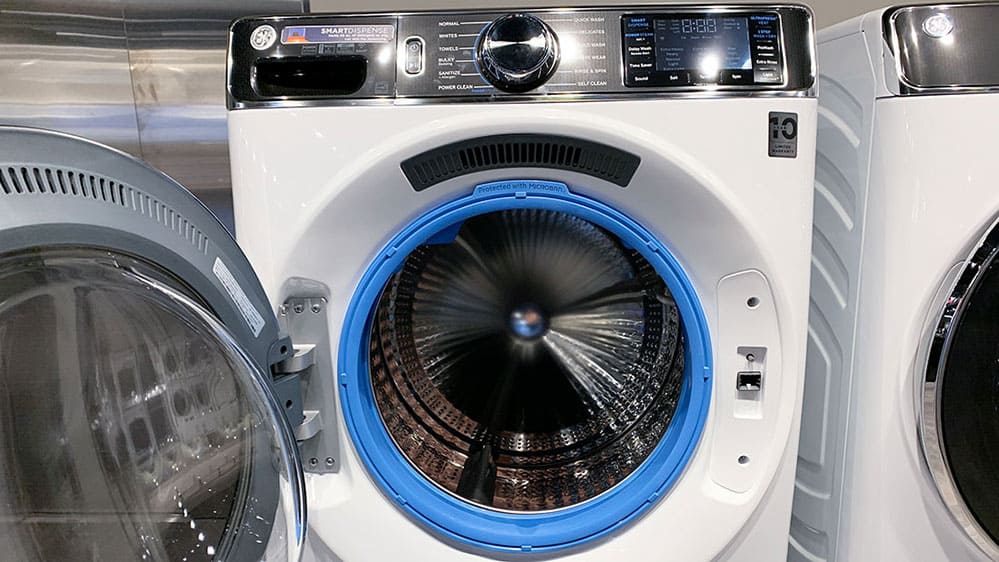
GE front load washers have Microban antimicrobial surfaces in the gasket, hoses, and dispenser to prevent the build-up of mold.
The “OdorBlock” fan inside the drum dries any residual moisture.
Samsung has introduced similar CleanGuard technology, just without the fan.
Front Load vs. Top Load Washers: Size
.jpg?width=799&height=450&name=Average-Size-of-Front-Load-and-Top-Load-Washers-(1).jpg)
Both top-load and front-load washers have grown in size.
Front-loads now average between 4.5 and 5.3 cubic feet for the most common models, with some as large as 6 cubic feet.
When it comes to top-load washers, you now have three types to consider.
Regular top-load washers are typically around 3.2 to 3.5 cubic feet and come with a larger agitator.
You can find basic models from Amana and Whirlpool, or even premium options like Speed Queen at this level.
From my recent experience with top-load washers, that agitator makes it tougher to load larger items like blankets and sheets.
Then you have the newer high-efficiency hybrid washers, which combine the convenience of a top-load with the capacity and efficiency of a front-load washer.
At least, they’re supposed to.
The impeller or no-agitator models are designed to clean clothes like a regular top-load, using a “diffuser” at the bottom.

As much as I like the concept, we haven’t seen any hybrid washers from any manufacturer that work well enough to clean clothes properly.
You can’t simply add a bigger drum and remove the agitator and expect the clothes to be spun correctly in the washer.
That’s why we don’t display or sell agitator-less hybrid washers at Yale.
Hybrids With Agitators
However, the hybrids with agitators from LG and Profile seem promising.
They offer a good capacity of 4.7 to 5.3 cubic feet, decent spin speeds, and even advanced features like automatic dispensers.

But keep in mind, a hybrid washer will have 0.6 to 0.8 cubic feet less usable space than advertised because of the agitator.
So, while front-loaders are far larger than regular top-load washers, they’re only slightly larger in usable cubic footage compared to hybrids.
Front Load vs. Top Load Washers: Energy Efficiency
Top-load washers use about 348 kWh of electricity annually, while front-loads use less than half at 159 kWh, and hybrids fall in the middle at around 212 kWh.
In Boston, where electricity costs 27.5 cents per kilowatt-hour, there’s a $25 difference per year to run a top-load versus a front-load, based on 1.5 hours of usage per day.
Front vs. Top Load Washers: Water Usage

The average top-load washer uses about 40 gallons of water and can fill up to 70 gallons on deep fill cycles, depending on the manufacturer.
Front-load washers, on the other hand, use about 10 to 14 gallons of water, with hybrids again falling in the middle at around 17 gallons.
The average water and sewer bill in Boston is $17.77 per 1,000 gallons, or 0.017 cents per gallon.
The average front-load washer costs about 21 cents per load.
In comparison, a top-load washer costs roughly 51 cents per load.
And because the capacity is smaller in top-load washers, you’d have to run more loads, multiplying that cost.
Read More: Most Efficient Clothes Washers
Front Load vs. Top Load Washers: Spin Speed
People don’t often talk about spin speed, but a higher spin speed is better.
A higher spin speed in your washer helps extract more water from your clothes, reducing drying time.
Front-load washers average between 1,160 and 1,300 RPM, with Miele and Bosch compact models reaching up to 1,600 RPM.
Top-load washers average around 700 RPM, while hybrids come in at about 850 RPM.
You’ll really notice the difference if you’re washing a full load of laundry.
My bed sheets, blankets, and even sweatpants had to be dried twice in the top-load set I had in my apartment last year.
From an efficiency standpoint, front-loaders are much better even when you consider the larger capacity.
Front Load vs. Top Load Washers: Which Washes Better?
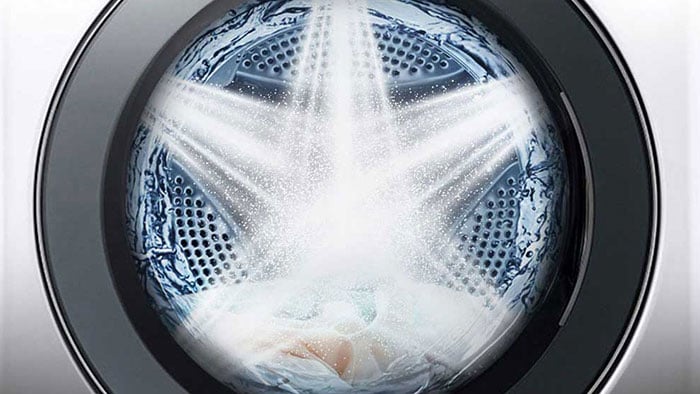
Even though front-load washers spin faster, they’re also gentler on your clothes.
The clothes effectively wash themselves by rubbing against each other during the wash cycle.
Top-load washers, on the other hand, are tougher on clothing because of the agitator.
Some people love that old Speed Queen TC5003 with its aggressive 270-degree agitation. Yes, it’s probably great for those grimy work clothes.

However, you should be careful with any other clothes. In my old top-load washer, clothes often got knotted around the agitator.
That never happened with any of the front-load washers I used over the past 20 years.
Interestingly, the new GE Profile hybrid top-load washer has a “knot cycle” to prevent knots from occurring.
So, from a washing and drying standpoint, a front-load washer will clean and dry your clothes better in less time and do it more efficiently.
Front Load vs. Top Load Washers: Cycles

Every machine, regardless of configuration, has plenty of cycles.
The average machine offers ten cycles and eleven options.
Even that older top-load has enough cycles.
My mom’s old Maytag had just three cycles, and it worked fine.
Front-load washers—and now the better hybrids—offer some more advanced cycles worth considering.
Steam Cycles

Steam loosens up tough stains so they can be powered out.
It’s almost standard for front-load washers and available on a few pricey top-load models.
Speed Cycles

Speed cycles are becoming popular in both styles. In most front-load machines, you can now wash a small load in about 15-30 minutes.
LG’s Turbo360 cycle, available in both their front-load and top-load washers, features five high-pressure wash jets for faster cleaning.
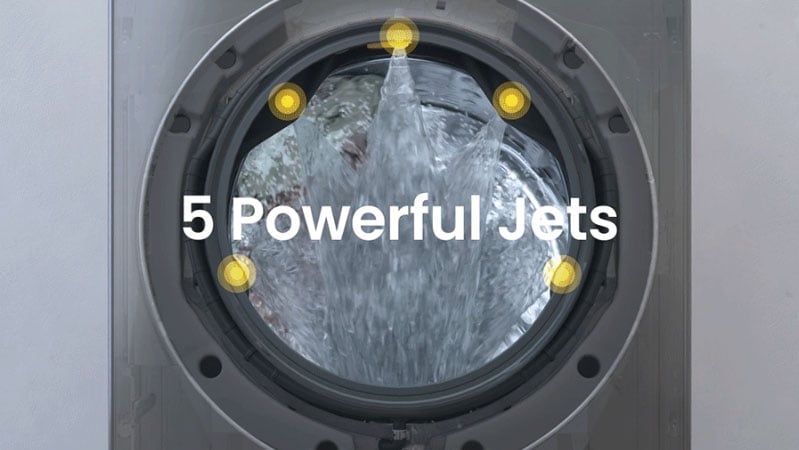
Front Load vs. Top Load Washers: Automatic Detergent Dispensers
Automatic detergent dispensing is a feature you should consider in every type of machine.
You can add 18-40 loads of detergent depending on the brand. It’s not just convenient.
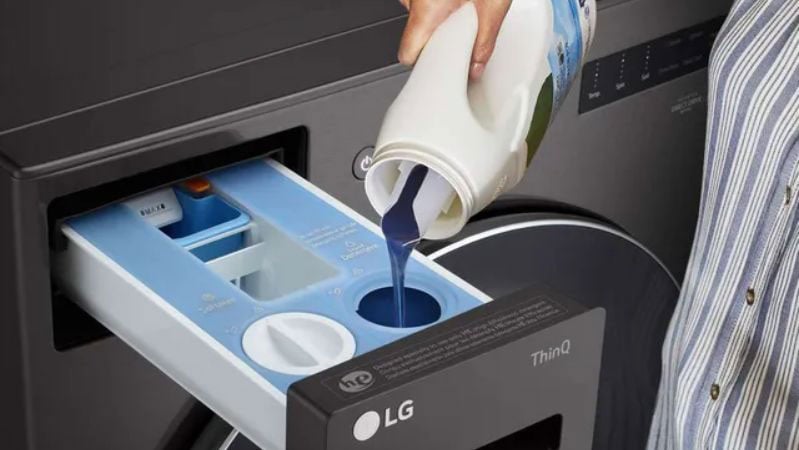
An automatic detergent dispenser will prevent you from using too much detergent in the wash.
Using too much detergent is a common problem with front-load washers because they use less water, so you only need a small amount—just a capful.
Excess detergent can cause foamy buildup, leading to mold, mildew, odors, and expensive service calls down the line.
Automatic dispensers are available on better front-load washers, and a more basic version is available on GE hybrids.
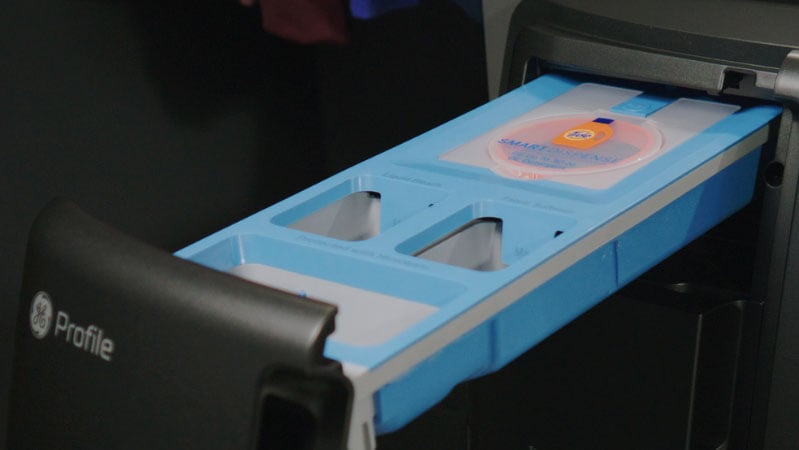
Some of these advanced features are only available on front-load washers and newer hybrids.
Front vs. Top Load: Compact Washers
You have more options with front-load washers, like 24-inch compact models that can fit easily in closets or even standard kitchen cabinets.
The most sophisticated washer of any type is Miele.
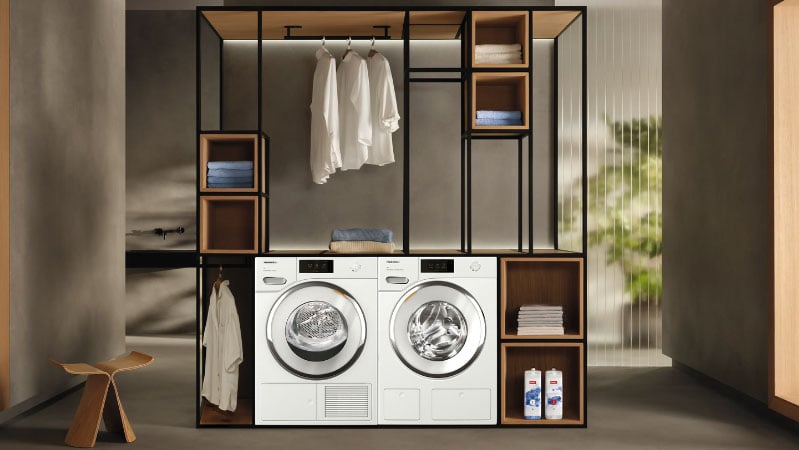
Miele washers and dryers feature a HoneyComb drum design that allows you to wash delicate items like silks and cashmeres.
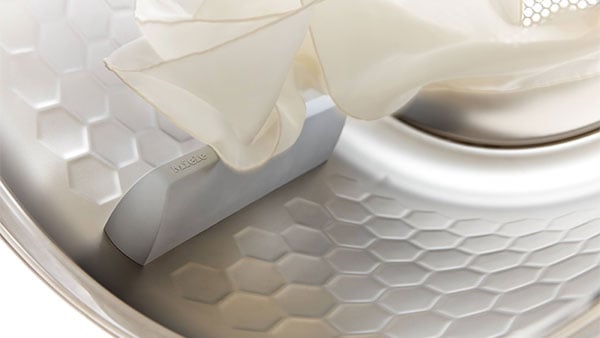
They also have the incredibly sophisticated “TwinDos” dispenser and an impressively fast 1600 RPM spin.
Other compact laundry brands to consider are LG and Bosch.
Whirlpool’s “ThinTwin” is a 24-inch top-load stackable unit that hasn’t changed much since I started in 1986. It has a tiny capacity and limited features.
However, the ThinTwin is $1,000 less expensive than a good compact front-load combo.
Combination Washers and Dryers

You’ve got the new popular combo washers and dryers from Profile, LG, and Samsung, where you can put your dirty clothes in and have them come out clean and dry.
Now you can complete a full load before bed or before heading to the office.
These front-load combos are equipped with high-efficiency heat pump dryers.
Heat pump dryers are the most efficient dryers available.
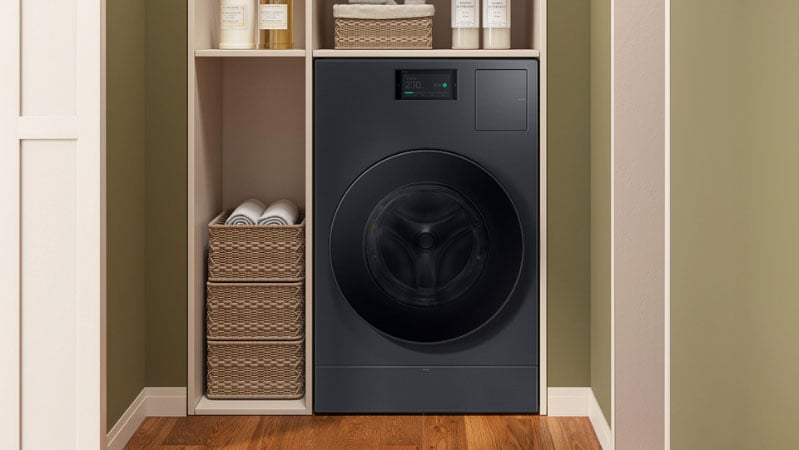
We’ve got tons of videos on these new combos.
But you should also know the cons.
While they’re convenient, combo washers and dryers can take longer than a separate washer and dryer, and you can’t reload the washer like you can with a separate set.
Plus, no one knows yet if the lint filter will hold up over time since they’re still new to the market.
This was a problem with older combos because lint buildup could seize the machine.
Front Load WashTowers
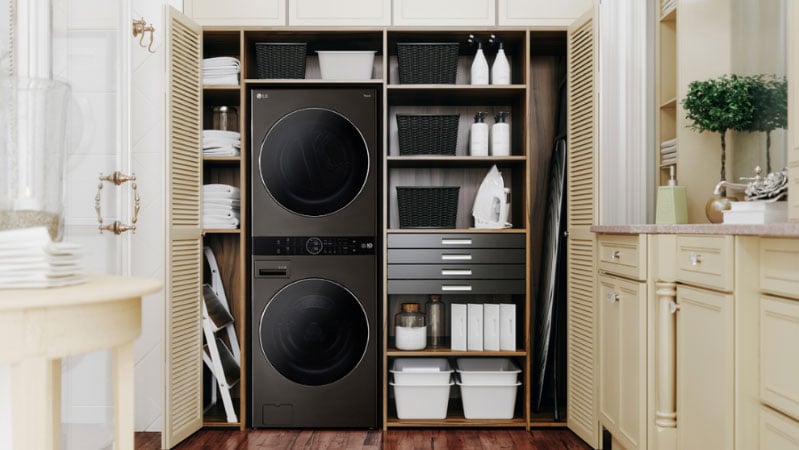
If there’s one piece of technology you should embrace in a front load, it’s the LG WashTower—especially if you’re stacking.
The controls are in the middle, so you don’t have to reach as much.
It also comes apart, making it easier for multi-floor deliveries and tight spaces.
It even has a ventless model with a heat pump dryer that uses far less energy.
We cover heat pumps in other videos.
They’re seriously worth considering for your next dryer. Their efficiency is that compelling.
Read More: LG WashTower Review
When to Buy a Top or Front Load Washer
Wait for a promotional holiday.
Any holiday.
Manufacturers increased capacity during the pandemic for demand that’s no longer there.
You can save 10-35%, plus even more with rebates.
By the way, that’s true for all appliances during any holiday.
These promotional holiday sales stretch into months, like Black Friday now running from Halloween until Cyber Monday, four days after Thanksgiving.
Read More: When Is the Best Time to Buy Appliances?
The Greatest Flood Protection Hack Ever
Now, I want to save you from a possible flood in your laundry room or kitchen.
This is the best hack ever, and it will cost you less than a dollar.
It works with any type of appliance, like a dishwasher or water heater, and can save you from a potential nightmare. It’s so simple.
Appliance deliveries are often subpar, so this will come in handy if your washer is installed incorrectly.
After any of our deliveries involving a dishwasher, washer, or refrigerator with a dispenser, we place specially designed laminated paper underneath to detect water leaks.
.jpg?width=799&height=450&name=Leak-Protection-Pads-With-Yale-Appliance%20(1).jpg)
If our clients see any water on the paper within 24 hours, they can call us to reinstall or fix the issue.
You can do almost the same thing.
Cut a piece of wax paper and place it underneath your appliance to detect any water issues.
After 24 hours, if you don’t see any water, just remove the paper.
Front Load vs. Top Load Washers: Key Takeaways
It really comes down to personal preference. I prefer front-load washers for their size and efficiency.
But I can see why you might prefer a top load. You don’t have to bend over, there’s less worry about mold, and you’ll save a few dollars.
Plus, you won’t be as frustrated if something goes wrong—top-load washers are simpler to repair.
Additional Resources
Get the Yale Washer Buying Guide with features, specs, and inside tips to all the brands, to dimensions and explanations of every washer and dryer type are included. Over 1 million people have read a Yale Guide.




.jpg?width=1200&height=675&name=Cafe-Appliances-in-Stainless-Steel%20(1).jpg)

